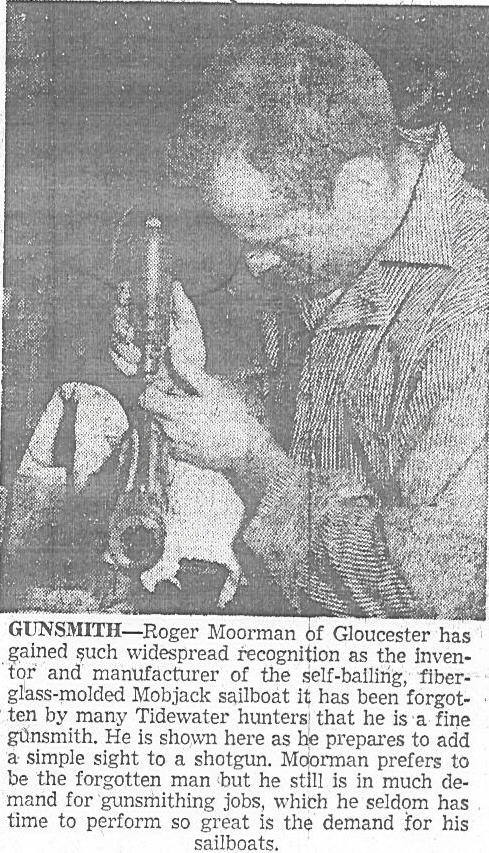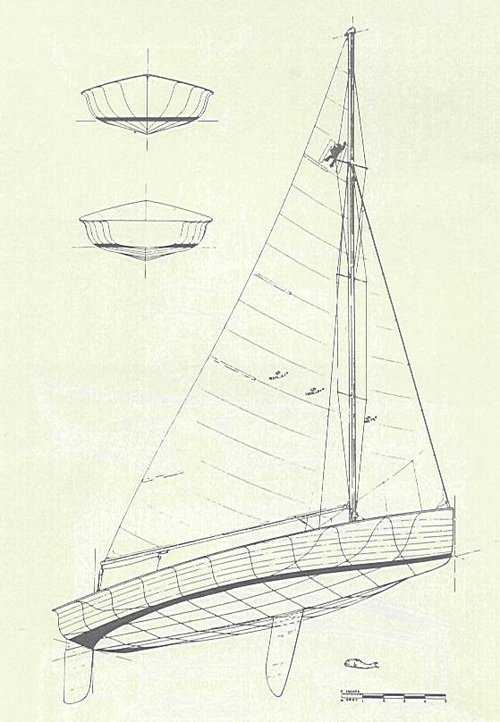By Jere Dennison
 By the mid-1950s, technological improvements arising from World War II were just beginning to filter down to the boat-building industry. Still sailboats continued to be constructed with wooden hulls that greatly restricted the application of mass production techniques. Wood, while light and strong, had limiting characteristics as well. It was difficult to form into exotic shapes and required extensive maintenance to prevent rot and decay in the marine environment.
By the mid-1950s, technological improvements arising from World War II were just beginning to filter down to the boat-building industry. Still sailboats continued to be constructed with wooden hulls that greatly restricted the application of mass production techniques. Wood, while light and strong, had limiting characteristics as well. It was difficult to form into exotic shapes and required extensive maintenance to prevent rot and decay in the marine environment.
Meanwhile sailboat racers began to demand higher performance. At FBYC this meant that Penguins and Hamptons began to be displaced with boats like the Thistle and latter the Jollyboat. Both of these boats were cold-molded in wood to produce efficient hulls with hydrodynamically superior shapes. But wood was still the material of choice as had been the case throughout maritime history.
In 1954, FBYC member Roger Moorman, a gunsmith from Gloucester Country who excelled in the Thistle class, began developing plans to create and produce a new type of one-design dinghy based roughly on the Thistle hull-form but constructed entirely of plastic.
During the summer of 1956, The Richmond Times-Dispatch reported on Rogers effort to pioneer this new, innovative fiberglass construction technique. Portions of the article entitled Gloucester Resident Designs, Constructs All-Plastic Sailboat as written by Jennings Culley are reprinted below:

Roger Moorman, businessman, boat builder and expert sailor of longstanding is now Roger Moorman, boat designer. The 34-year old Gloucester resident has designed and constructed a new sailboat that is called the Mobjack.
The boat is a 17-foot all-plastic job that is virtually unsinkable and comes with such innovations as a self-bailing system. It is the incorporation of ideas Moorman has picked up in his years of sailing concerning what a sailboat should be in design, function and safety features.
The boat makes use of several new techniques in the ever-growing field of plastics. Because of this, there have been many headaches, many stumbling blocks and many delays getting it into mass production.
Weve been working for some 18 months now and were not quite out of the research stage and into the production stage, said Moorman, But were almost there. With some of these new techniques with plastics, we have had to feel our way along. We cant go somewhere and see how somebody else is doing it, 'cause nobody else is doing it yet. Its been quite a job, but the end product is well worth the trouble and cost weve gone to.
The end product is actually a double-bottom plastic (or fiberglass) boat about the size of a Thistle. It has a 26-foot mast with 175 square feet of working sails (slightly more than the Thistle). The length & width are about the same as a Thistle, but the weight of the Mobjack is less-about 295 pounds.
The Mobjack has decking (or seats) along the gunwales but no cross seats like the Thistle. It will carry as many as eight persons under normal sailing conditions.
Moorman finished construction of his first Mobjack last fall and has registered it as an official sailing class at the Fishing Bay Yacht Club. He recently finished his second one and is hoping to complete a third one next week so that the three can be entered into active competition at the Ware River Yacht Club regatta on August 4.
The official emblem for the Mobjack class will be a large M with a shouting sailor just beneath. It will signify Mock Jack, said to be the original name of Mobjack Bay. According to Bob Burgess of the Mariners Museum in Warwick, the bay was call Mock-Jack by early sailors because their voices echoed to them as they sailed along the wooded shores of the bay.
Virginia sailors have taken to the Mobjack very well, Moorman said. We have orders for quite a few already. The features offered by the boat are the ones people go for. The self-bailing, the wide-openess of the boat and the durable structure please people. Now its up to us to get it into production.
Fortuitously, Roger did not complete his third boat in time to enter the class in the Ware River regatta. This allows FBYC to lay claim as the first racing venue of the Mobjack during its Annual Regatta held over August 18 & 19, 1956. The final standings for the Mobjack class were Alan Hicks in 1st place followed by Roger Moorman, 2nd, and Andy Sinnickson, 3rd. All were FBYC members.
From this humble start, the Mobjack fleet took off like the contemporaneous Russian sputnik. Early fleet members in our Club, beside Hicks, Moorman, and Sinnickson, included Jimmy Reid, Chuck Raynor, Fred Williams, Harrison Hubard (Sr.), and Bill Pierce.
 |
| Moorman at the helm in 1962 |
By 1959, as reported by the Log in March of that year, the Class had drafted a Constitution, By-Laws and Racing Rules. The Class now included representatives in New Jersey, New York, Long Island, Maryland, Indiana, and Florida. Hull number 28 had just been completed and orders were backlogged through hull number 35. Truly, the Mobjack had become an astounding success in the one-design world and doubtlessly contributed to the explosion in fiberglass dinghy construction in the years that followed when glass rapidly supplanted wood as the material of choice.
In the summer of 1959 to promote the class, Roger Moorman created a sensation by sailing his Mobjack some 135 miles from Gloucester to Annapolis, Maryland for a racing event. And in 1959, FBYC hosted the first Mobjack National Championship.
As testament to the endurance of the Mobjack design, the class is still actively raced at many yacht clubs primarily in the Chesapeake region, but also on Smith Mountain Lake, in Lewes, Del. and Long Island, NY and on several lakes in Wisconsin and is the longest surviving one-design class at FBYC where it has been continuously raced for over 45 years.
Did you know?
- Of the early Mobject fleet members, five became Commodores of FBYC. They were Allan Hicks, Harrison Hubard (Sr.), Chuck Raynor, Fred Williams, and Jimmy Reid.
- Fred Williams purchased Moormans Mobjack prototype, Orange Crate, that bore an X on the sail rather than a sail number. Evidently the only difference between the prototype and the boats manufactured later was a slightly finer waterline entry at the bow on the prototype. Nevertheless, Orange Crate was grandfathered into the rules allowing her to race one-design in spite of the deviant hull-form.
- The Mobjack was not an early adopter of the trapeze rig, thereby requiring a crew of three to be competitive. The trapeze approved during the 1970s allowed the boat to be raced with a crew of two while maintaining an adequate righting moment.
- Nationally competitive FBYC Mobjack skippers in recent years include the father-son combination of Case and Rob Whittemore.